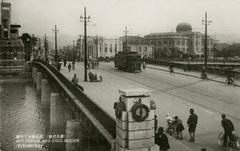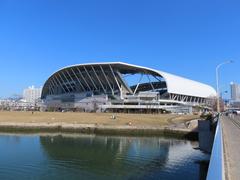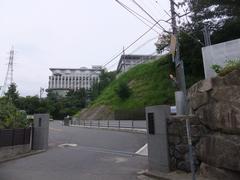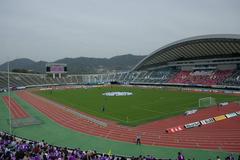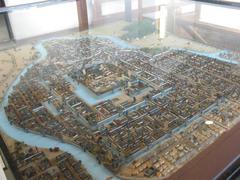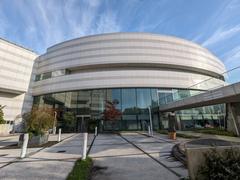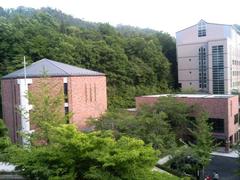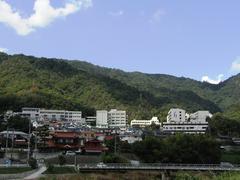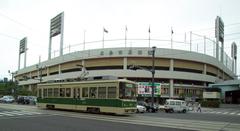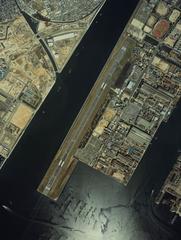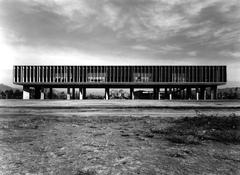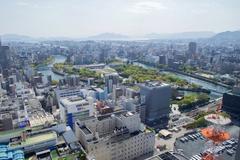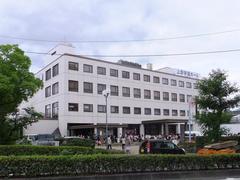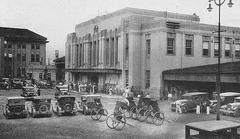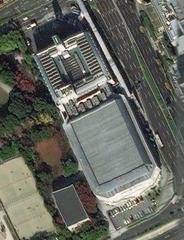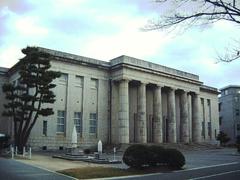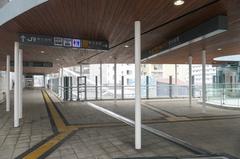
Hatchobori Station Hiroshima: Visiting Hours, Tickets, and Nearby Historical Sites Guide
Date: 04/07/2025
Introduction to Hatchōbori Station and Its Significance
Hatchōbori Station lies at the heart of Hiroshima’s vibrant downtown, serving as a nexus of history, culture, and urban life. Originally rooted in the castle town established by warlord Mōri Terumoto in the late 16th century, the area has evolved from a feudal stronghold into a modern commercial and transit hub. Today, Hatchōbori exemplifies Hiroshima’s remarkable resilience and capacity for renewal, seamlessly blending historic landmarks with contemporary shopping, dining, and entertainment.
The district’s transformation accelerated after the Meiji Restoration, particularly with the expansion of the Hiroshima Electric Railway streetcar network in the early 20th century. This development solidified Hatchōbori’s role as a key economic and transportation center. Despite the devastation wrought by the atomic bombing in 1945, the district was revitalized through innovative urban planning, resulting in wide boulevards, green spaces, and a dynamic mix of residential and commercial areas (Japan Society; World Bank).
Today, Hatchōbori Station serves multiple streetcar lines, offering convenient access to Hiroshima’s major attractions, including Peace Memorial Park, Hiroshima Castle, and bustling shopping arcades. This guide details everything you need to know about visiting Hatchōbori, from practical information and ticketing to cultural highlights and nearby historical sites (Dive Hiroshima; JP Rail).
Table of Contents
- Early Urban Foundations and Historical Context
- Modernization and Industrialization
- Wartime Destruction and Postwar Reconstruction
- Hatchōbori’s Role in Urban Renewal
- Practical Visitor Information
- Contemporary Urban Fabric and Significance
- Hatchōbori in Numbers
- Cultural and Social Layers
- Frequently Asked Questions (FAQ)
- Summary & Visitor Tips
- Sources
Early Urban Foundations and Historical Context
Hatchōbori’s origins are intertwined with the establishment of Hiroshima Castle in the late 1500s. The castle’s presence fostered the growth of a bustling castle town, attracting samurai, artisans, and merchants. Strategic development by the Mōri, Fukushima, and Asano clans included bridge construction and infrastructure that connected river islands, supporting commerce and laying the groundwork for the city’s future expansion (aboutjapan.japansociety.org).
During the Tokugawa era, Hiroshima’s importance grew, with the Asano lords facilitating land reclamation and rerouting the Sanyō highway through the city’s core. By the 18th century, Hiroshima had become the largest city in the Chūgoku region.
Modernization and Industrialization
The Meiji era ushered in rapid modernization, with Hiroshima’s strategic location linking Kyūshū to the Seto Inland Sea and major industrial cities. The opening of Ujina Port and the extension of the Sanyō Railroad in the late 19th century accelerated industrial and commercial growth, leading to the creation of cotton mills and other light industries. Hatchōbori emerged as a central district for commerce and transit, a role it maintains today (dive-hiroshima.com).
Wartime Destruction and Postwar Reconstruction
On August 6, 1945, Hiroshima was devastated by the atomic bomb, with Hatchōbori among the affected areas. Reconstruction began swiftly, guided by the Hiroshima Peace City Construction Law of 1949. Urban planning focused on creating wide boulevards, green spaces, and modern infrastructure. Motomachi Redevelopment Project (1969–1978) further transformed the district, replacing informal settlements with modern apartments and civic facilities like the Hiroshima Central Library (World Bank; triptojapan.com).
Hatchōbori’s Role in Urban Renewal
Today, Hatchōbori is a vibrant intersection of Aioi Street and Chūō Street, lined with department stores, restaurants, and entertainment venues. The Hiroshima Electric Railway (Hiroden) streetcar network cements the district’s role as a key transit hub, connecting visitors to Hiroshima Station, Peace Memorial Park, and other major attractions (jprail.com).
Practical Visitor Information
Visiting Hours
Hatchōbori is an open district, accessible at all hours. Most shops and department stores operate from 10:00 AM to 8:00 PM, while restaurants and nightlife venues often remain open later.
Tickets & Transit Access
- District Access: No admission fee is required to explore Hatchōbori.
- Streetcar Tickets: Purchase at stations, on trams, or use IC cards (PASPY, Suica). Day passes are available for unlimited rides.
- Attraction Tickets: Fees apply for nearby sites such as Hiroshima Castle and museums.
Getting There
Reach Hatchōbori by Hiroshima Electric Railway streetcar, with the Hatchōbori stop served by multiple lines and direct connections from Hiroshima Station and Peace Memorial Park. The district is also walkable from other central locations.
Accessibility
Hatchōbori is generally accessible, with barrier-free facilities at most transit stops, shops, and restaurants.
Best Times to Visit
Visit during the day for shopping and sightseeing, or in the evening for lively dining and nightlife. Spring and autumn offer pleasant weather, while seasonal festivals provide unique cultural experiences.
Nearby Attractions
- Peace Memorial Park: Open daily, 8:30 AM–6:00 PM, including the Atomic Bomb Dome and Peace Memorial Museum.
- Hiroshima Castle: Open 9:00 AM–6:00 PM, a short tram ride or walk from Hatchōbori.
- Shukkeien Garden: Historical Japanese garden, especially beautiful in cherry blossom season.
- Motomachi Shopping Arcade: Adjacent to Hatchōbori, ideal for souvenirs and local crafts.
Guided Tours & Photo Spots
Join guided walking tours covering historical and cultural highlights or capture iconic cityscapes along Aioi Street, the streetcar intersections, and Peace Boulevard.
Contemporary Urban Fabric and Significance
Hatchōbori blends historic character with modern amenities. The district is home to new hotels, craft beer bars, izakayas, and specialty coffee shops. Walkable streets and green spaces enhance urban life, while the area’s central location makes it a gateway to Hiroshima’s historical and commercial attractions (dive-hiroshima.com; explorehiroshima.jp; triptojapan.com).
Hatchōbori in Numbers
- Population Recovery: Hiroshima’s population rebounded from 83,000 post-bombing to over 300,000 by the mid-1950s (World Bank).
- Transit Usage: The Hiroshima Electric Railway network serves over 150,000 passengers daily through nodes like Hatchōbori (jprail.com).
- Commercial Density: The district hosts a dense array of department stores, hundreds of restaurants, and a growing number of hotels (dive-hiroshima.com).
Cultural and Social Layers
Hatchōbori reflects Hiroshima’s journey from a feudal town to a cosmopolitan city. The area’s vibrancy is amplified by seasonal festivals, street performances, and public art, while its proximity to memorial sites keeps the city’s legacy alive. Contemporary trends like craft beer and specialty coffee coexist with traditional izakayas and long-established retailers, embodying Hiroshima’s spirit of remembrance and renewal (explorehiroshima.jp).
Frequently Asked Questions (FAQ)
Q: What are Hatchōbori’s visiting hours?
A: The district is accessible 24/7. Businesses typically open from 10:00 AM to 8:00 PM, with nightlife venues open later.
Q: Do I need tickets to visit Hatchōbori?
A: No, but tickets are required for specific attractions (e.g., museums, Hiroshima Castle).
Q: How do I get to Hatchōbori?
A: Take the Hiroshima Electric Railway streetcar to the Hatchōbori stop; it connects directly to Hiroshima Station and other key sites.
Q: Is Hatchōbori wheelchair accessible?
A: Yes, most facilities and transit stops are accessible.
Q: Are guided tours available?
A: Yes, many walking tours include Hatchōbori and nearby historical sites.
Summary & Visitor Tips
Hatchōbori Station embodies Hiroshima’s resilience, blending centuries of history with a lively modern atmosphere. As a central transit hub and commercial center, it provides easy access to Hiroshima’s most important sites, from Peace Memorial Park and Hiroshima Castle to vibrant shopping arcades and culinary hotspots. The district’s pedestrian-friendly streets, accessible infrastructure, and diverse events make it a welcoming destination for all travelers (Trip to Japan; Explore Hiroshima).
Visitor Tips:
- Use streetcar day passes for cost-effective travel.
- Visit popular sites early or late in the day to avoid crowds.
- Check for seasonal festivals and events for a richer cultural experience.
- Take advantage of accessible facilities and tourist information centers.
- Explore both the historic and modern aspects of the district for a comprehensive experience.
For the latest updates, download the Audiala app and follow official Hiroshima tourism resources. Your journey through Hatchōbori offers a unique window into the city’s enduring spirit and dynamic culture.
Sources
- Japan Society: Hiroshima History & City Events
- PlanetWare: Hiroshima Attractions
- Hiroshima City Overview
- Japan Travel: Hiroshima Complete Guide
- World Bank: Hiroshima Urban Recovery
- Dive Hiroshima: Nightlife and Features of Hatchōbori
- JP Rail: Hiroshima Station Guide
- Trip to Japan: Hiroshima History, Culture, and Charm
- Explore Hiroshima: Memory, Nature, and Local Flavor
- Hiroshima Peace Memorial Museum
- UNESCO World Heritage Listing for Atomic Bomb Dome
- Hiroshima City Tourism Official Website




